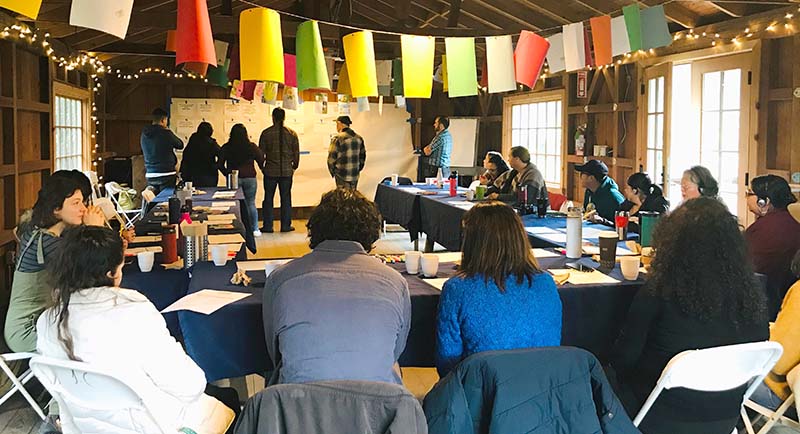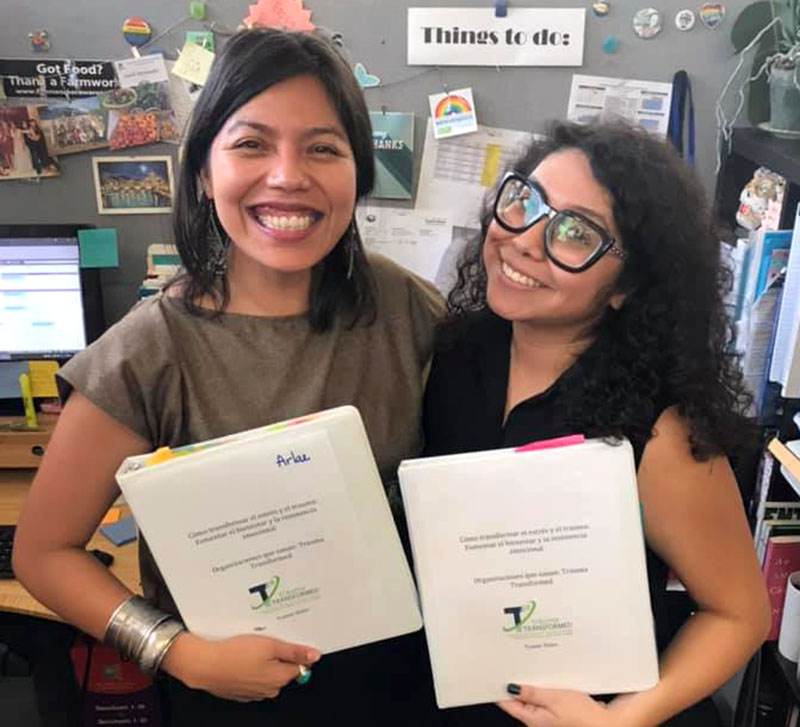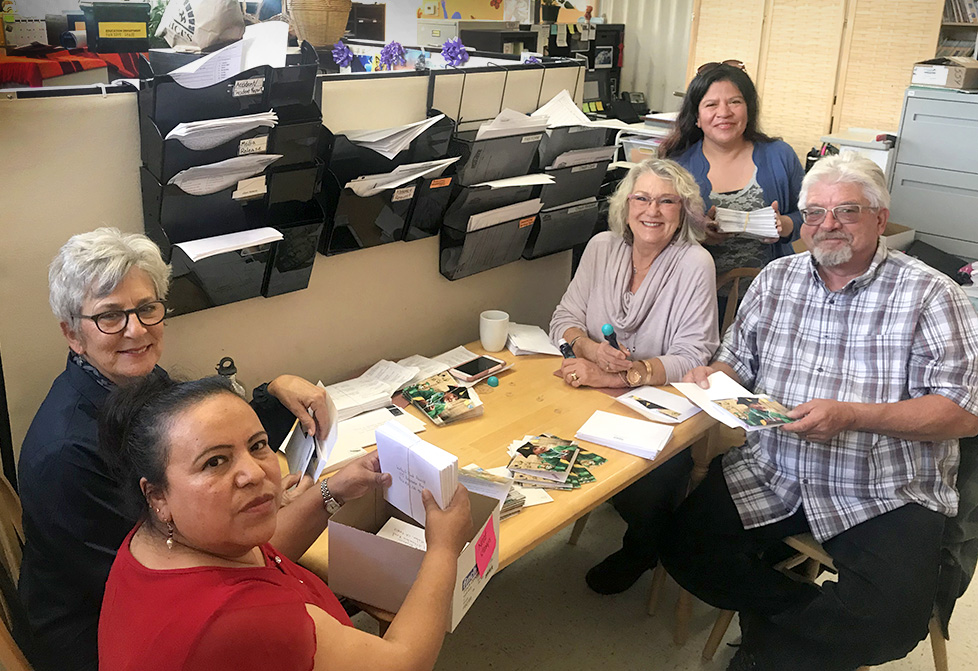
Puente’s strategic planning process: a fresh look into the future
At Puente, the new year brings with it a unique opportunity to chart its path forward into the future – a process known as strategic planning. It’s a process that takes the time to ask fundamental questions about Puente’s function and role, and explicitly makes room for new dreams and possibilities.
“I’m excited about this process. Right now, everything is on the table, and I like it, because some things we’ve never questioned before,” says Rita Mancera, Executive Director of Puente.
Puente is several months deep into constructing a strategic plan that will carry it 3 to 5 years into the future. It’s not the first strategic plan that Mancera has been a part of – Puente is very experienced in this area – but it is the first one that she will have overseen from start to finish.
It’s a huge priority that everyone involved – Puente staff, the board of directors, community members, and program partners – has a chance to contribute opinions and ideas. To that end, Mancera has contracted Miguel Gavaldon, a bilingual and bicultural nonprofit coach, trainer and consultant, to facilitate conversations within Puente’s sphere and with community groups.
“We have a lot of new staff, and I think it’s very important that the people who are working here are part of the process of defining where we’re going next,” says Mancera, adding that Puente’s board of directors is in a similar position. Its members, who reflect a new era of board leadership, have completely turned over in the last three years, except for two people who are providing great historical insight for this process.
For the past few months, Puente has been in an idea-generation and data-gathering phase, overseen by a steering committee comprised of board members, managers, support staff and Mancera. Starting in late January, Puente will start soliciting input from partners and community members. Specifically, Puente is planning three community focus groups to discuss the agricultural economy from the diverse perspectives of farmers and farm workers, and other folks whose lives have been impacted by the changing face of agriculture on the South Coast.
Puente is also planning three focus groups to talk about local K-12 education. Gavaldon will invite high school students, alumni and families to share their experiences as students and where they feel there are gaps that Puente should address.
Gavaldon’s approach to strategic planning is aligned with Puente’s. When an organization is serious about its public service mandate, he believes it’s essential to cast a wide net and take the time to include a multiplicity of experiences. He says he has been struck by Puente’s commitment to those values, as compared with some other nonprofits.
“It’s quite rare. Most strategic planning processes I’ve observed might check in with community members, but ultimately it comes down to the preferences of the board, the competencies of the staff, and what funders want to support. It’s more about how to sustain the institution,” he says.
Meanwhile, Puente’s approach has been completely different.
For most nonprofits, a strategic plan is a way to determine how an organization will allocate resources for the next few years according to a list of internal priorities. Within Puente, however, crafting a strategic plan is a much more ambitious undertaking: one which draws heavily on community outreach, and considers participants at every turn.
“Puente doesn’t start with, ‘How do we make more money?’ The question is, ‘How do we make the maximum impact for who we serve?… And by the way, are we clear on who we serve? Are folks clear that we’re here for them?’ That’s the driving force behind it.”
Puente has a rich history of leading public workshops and large outreach efforts on the South Coast, including the major role it played in the recent Pescadero Town Planning Initiative and gathering.
During the focus groups, Gavaldon will be likely to ask participants questions such as, how can parents collectively elevate their voices within policy and systems discussions in their children’s schools? And when it comes to the farm economy, what are the benefits to farmers who prioritize the well-being of their farm workers? How could more farmers be supported in considering changes in their practices that are beneficial to farm workers?
The way Puente is coming up with its priorities for the next 3 to 5 years is by asking: where does the organization want to be in 30 years? What kind of community do people want to see? “We’re working backwards from that vision to where we are now,” says Mancera.
And along the way, Puente intends to question a lot about itself. There are no givens, no sacred cows. Turning a blank canvas into a roadmap means that everyone will be able to see where they’re going together, because they designed the blueprint for it.
“It’s about going a few layers deeper into questions that define us and therefore our work, which seems really important right now,” says Mancera.
Is Puente a political organization? If so, political in which ways? If Puente were to take on a more explicit advocacy role, what issues would it advocate for and how?
Yet another question: whom does Puente serve? “For a long time, we have implied we serve everyone. Who is our target? And is our target a geographical region, or something else?” says Mancera.
And what do participants think about the multiplicity of programs and activities Puente offers? Is there a better way to staff and operate them? Could Puente have more impact by doing fewer things?
The strategic plan will be completed in June, with the results published online and shared in other accessible ways.
The question of Puente’s role in an advocacy space is also about finding long-term ways to organize community members so that they may develop a stronger voice and presence on issues that affect them – to build power at the grassroots to speak to government planning processes, for instance.
“Puente serves, literally, as a bridge between the powerful and those who have the potential to build power,” says Gavaldon.
Mancera agrees. “The question is, could we build those skills in a more structured way so that they don’t need to come to Puente – because they know how to advocate for themselves?”
Other areas likely to see change in the next few years include Puente’s facilities, which are inadequate for staff and for participants; a redoubled focus on connecting Puente youth to career options as they evolve through the IDEA program; and action on one or more Pescadero town planning priorities that emerged by consensus this summer.
It’s not just about choosing areas of focus. Mancera wants to build a platform for the values that Puente represents – something strong enough to carry it into a future without her at the helm. She has no plans to step down as executive director anytime soon, but she will someday.
“Our model is not a top-down charity, but a horizontal empowering effort where we work together with community members,” she says. “And so, I need to ensure that Puente can continue to be an organization that has those values up front. The operation may change, but the values will continue in the work that we do.”
Proceso de planificación estratégica de Puente: una nueva mirada hacia el futuro
En Puente, el nuevo año trae consigo una oportunidad única para trazar su camino hacia el futuro, un proceso conocido como planificación estratégica. Es un proceso que toma tiempo para hacer preguntas fundamentales sobre la función y el papel de Puente, y explícitamente deja espacio para nuevos sueños y posibilidades.
“Estoy entusiasmada con este proceso. En este momento, todo está sobre la mesa, y me gusta, porque algunas cosas que no hemos cuestionado antes”, dice Rita Mancera, Directora Ejecutiva de Puente.
Puente tiene varios meses de profundidad en la construcción de un plan estratégico que lo llevará de 3 a 5 años en el futuro. No es el primer plan estratégico del que Mancera ha formado parte, Puente tiene mucha experiencia en esta área, pero es el primero que supervisará de principio a fin.
Es una gran prioridad que todos los involucrados, el personal de Puente, la junta directiva, los miembros de la comunidad y los socios del programa, tengan la oportunidad de aportar opiniones e ideas. Con ese fin, Mancera ha contratado a Miguel Gavaldon, un capacitador bilingüe y bicultural, que trabaja con organizaciones sin fines de lucro, para facilitar las conversaciones dentro de la esfera de Puente y con grupos comunitarios.
“Tenemos una gran cantidad de personal nuevo, y creo que es muy importante que las personas que trabajan aquí sean parte del proceso de definir hacia dónde vamos después”, dice Mancera, y agrega que la junta directiva de Puente está en una situación similar.. Sus miembros, que reflejan una nueva era de liderazgo de la junta, se han volcado por completo en los últimos tres años, a excepción de dos personas que están proporcionando una gran visión histórica de este proceso.
Durante los últimos meses, Puente ha estado en una fase de generación de ideas y recopilación de datos, supervisado por un comité directivo compuesto por miembros de la junta, gerentes, personal de apoyo y Mancera. A partir de fines de enero, Puente comenzará a solicitar aportes de socios y miembros de la comunidad. Específicamente, Puente está planeando tres grupos de enfoque comunitario para discutir la economía agrícola desde las diversas perspectivas de los agricultores y trabajadores agrícolas, y otras personas cuyas vidas se han visto afectadas por la cara cambiante de la agricultura en la costa sur.
Puente también está planeando tres grupos focales para hablar sobre la educación local de K-12. Gavaldon invitará a estudiantes de secundaria, ex alumnos y familias a compartir sus experiencias como estudiantes y donde sientan que hay brechas que Puente debe abordar.
El enfoque de Gavaldon para la planificación estratégica está alineado con el de Puente. Cuando una organización se toma en serio su mandato de servicio público, cree que es esencial lanzar una red amplia y tomarse el tiempo para incluir una multiplicidad de experiencias. Él dice que ha quedado impresionado por el compromiso de Puente con esos valores, en comparación con otras organizaciones sin fines de lucro.
“Es bastante raro. La mayoría de los procesos de planificación estratégicos que he observado pueden consultar a los miembros de la comunidad, pero en última instancia se trata de las preferencias de la junta, las competencias del personal y lo que los patrocinadores quieren apoyar. Se trata más de cómo sostener la institución”, dice.
Mientras tanto, el enfoque de Puente ha sido completamente diferente.
Para la mayoría de las organizaciones sin fines de lucro, un plan estratégico es una forma de determinar cómo una organización asignará recursos para los próximos años de acuerdo con una lista de prioridades internas. Sin embargo, dentro de Puente, la elaboración de un plan estratégico es una tarea mucho más ambiciosa: una que se basa en gran medida en el alcance comunitario y considera a los participantes en todo momento.
“Puente no comienza con” ¿Cómo hacemos más dinero? “. La pregunta es:” ¿Cómo causamos el máximo impacto a quienes servimos? … Y por cierto, ¿tenemos claro a quién servimos? ¿Está claro que estamos aquí por ellos? “Esa es la fuerza impulsora detrás de eso”.
Puente tiene una rica historia de importantes talleres públicos y grandes esfuerzos de divulgación en la costa sur, incluido el importante papel que desempeñó en la reciente Iniciativa y reunión de Planificación Rural de Pescadero.
Durante los grupos focales, es probable que Gavaldon haga preguntas a los participantes, como ¿cómo pueden los padres elevar colectivamente sus voces dentro de las discusiones de políticas y sistemas en las escuelas de sus hijos? Y cuando se trata de la economía agrícola, ¿cuáles son los beneficios para los agricultores que priorizan el bienestar de sus trabajadores agrícolas? ¿Cómo se podría apoyar a más agricultores al considerar cambios en sus prácticas que sean beneficiosos para los trabajadores agrícolas?
La forma en que Puente plantea sus prioridades para los próximos 3 a 5 años es preguntando: ¿dónde quiere estar la organización en 30 años? ¿Qué tipo de comunidad quieren ver las personas? “Estamos trabajando hacia atrás desde esa visión hasta donde estamos ahora”, dice Mancera.
Y en el camino, Puente intenta cuestionarse mucho sobre sí mismo. No hay regalos, ni vacas sagradas. Convertir un lienzo en blanco en una hoja de ruta significa que todos podrán ver hacia dónde van juntos, porque diseñaron el plan para ello.
“Se trata de profundizar un poco más en las preguntas que nos definen y, por lo tanto, nuestro trabajo, que parece realmente importante en este momento”, dice Mancera.
¿Puente es una organización política? Si es así, ¿política de qué manera? Si Puente asumiera un papel de defensa más explícito, ¿qué temas abogaría y cómo?
Otra pregunta más: ¿a quién sirve Puente? “Durante mucho tiempo, hemos implicado que servimos a todos. ¿Quién es nuestro objetivo? ¿Y nuestro objetivo es una región geográfica, o algo más? ”, Dice Mancera.
¿Y qué piensan los participantes sobre la multiplicidad de programas y actividades que ofrece Puente? ¿Hay una mejor manera de organizar y planear estos programas? ¿Podría Puente tener más impacto al hacer menos cosas?
El plan estratégico se completará en junio, con los resultados publicados en línea y compartidos de otras maneras accesibles.
La cuestión del papel de Puente en un espacio de defensa también se trata de encontrar formas a largo plazo de organizar a los miembros de la comunidad para que puedan desarrollar una voz y una presencia más fuertes en los problemas que los afectan: construir el poder desde la base para hablar en los procesos de planificación del gobierno, por ejemplo.
“Puente sirve, literalmente, como un puente entre los poderosos y aquellos que tienen el potencial de construir más abogacia”, dice Gavaldon.
Mancera está de acuerdo. “La pregunta es, ¿podríamos desarrollar esas habilidades de una manera más estructurada para que no necesiten venir a Puente, porque saben cómo abogar por ellos mismos?”
Otras áreas que probablemente verán cambios en los próximos años incluyen las instalaciones de Puente, que son inadecuadas para el personal y los participantes; un enfoque redoblado en conectar a los jóvenes de Puente con las opciones de carrera a medida que evolucionan a través del programa IDEA; y acción sobre una o más prioridades de planificación urbana de Pescadero que surgieron por consenso este verano.
No se trata solo de elegir áreas de enfoque. Mancera quiere construir una plataforma para los valores que representa Puente, algo lo suficientemente fuerte como para llevarlo a un futuro sin ella a la cabeza. Ella no tiene planes de renunciar como directora ejecutiva en el corto plazo, pero algún día lo hará.
“Nuestro modelo no es una organización benéfica de arriba hacia abajo, sino un esfuerzo de empoderamiento horizontal donde trabajamos junto con miembros de la comunidad”, dice ella. “Y, entonces, necesito asegurarme de que Puente pueda continuar siendo una organización que tenga esos valores por adelantado. La operación puede cambiar, pero los valores continuarán en el trabajo que hacemos “.






